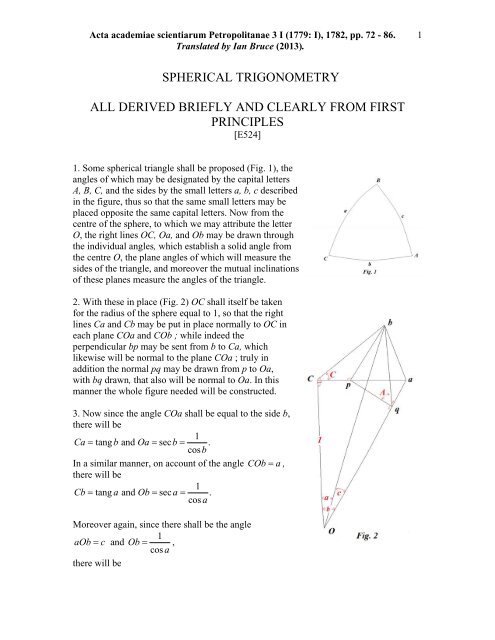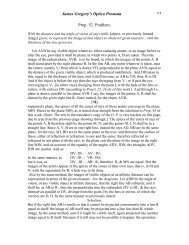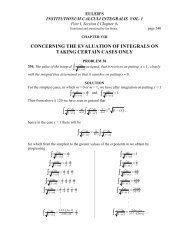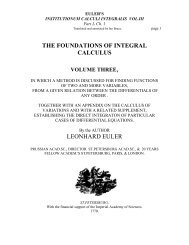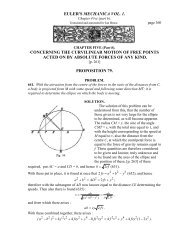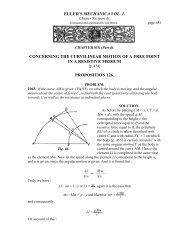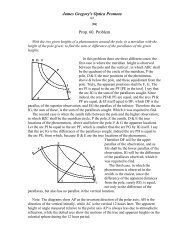TRIGONOMETRIA SPHAERICA UNIVERSA
TRIGONOMETRIA SPHAERICA UNIVERSA
TRIGONOMETRIA SPHAERICA UNIVERSA
You also want an ePaper? Increase the reach of your titles
YUMPU automatically turns print PDFs into web optimized ePapers that Google loves.
Acta academiae scientiarum Petropolitanae 3 I (1779: I), 1782, pp. 72 - 86. 1<br />
Translated by Ian Bruce (2013).<br />
SPHERICAL TRIGONOMETRY<br />
ALL DERIVED BRIEFLY AND CLEARLY FROM FIRST<br />
PRINCIPLES<br />
[E524]<br />
1. Some spherical triangle shall be proposed (Fig. 1), the<br />
angles of which may be designated by the capital letters<br />
A, B, C, and the sides by the small letters a, b, c described<br />
in the figure, thus so that the same small letters may be<br />
placed opposite the same capital letters. Now from the<br />
centre of the sphere, to which we may attribute the letter<br />
O, the right lines OC, Oa, and Ob may be drawn through<br />
the individual angles, which establish a solid angle from<br />
the centre O, the plane angles of which will measure the<br />
sides of the triangle, and moreover the mutual inclinations<br />
of these planes measure the angles of the triangle.<br />
2. With these in place (Fig. 2) OC shall itself be taken<br />
for the radius of the sphere equal to 1, so that the right<br />
lines Ca and Cb may be put in place normally to OC in<br />
each plane COa and COb ; while indeed the<br />
perpendicular bp may be sent from b to Ca, which<br />
likewise will be normal to the plane COa ; truly in<br />
addition the normal pq may be drawn from p to Oa,<br />
with bq drawn, that also will be normal to Oa. In this<br />
manner the whole figure needed will be constructed.<br />
3. Now since the angle COa shall be equal to the side b,<br />
there will be<br />
1<br />
Ca tang b and Oa sec b .<br />
cosb<br />
In a similar manner, on account of the angle COb a ,<br />
there will be<br />
1<br />
Cb tang a and Ob sec a .<br />
cos a<br />
Moreover again, since there shall be the angle<br />
1<br />
aOb cand Ob ,<br />
cos a<br />
there will be
Acta academiae scientiarum Petropolitanae 3 I (1779: I), 1782, pp. 72 - 86. 2<br />
Translated by Ian Bruce (2013).<br />
sin c cosc<br />
bq and Oq .<br />
cos a cos a<br />
Hence for the remaining lines of the figure being expressed, on account of the angle<br />
aCb C , there will be<br />
and<br />
from which again it is gathered,<br />
bp Cbsin C tang a sin C<br />
Cp CbcosC tang a cos C,<br />
ap CaCp tangb tang a cosC<br />
,<br />
and because the angle CaO 90b, there will be had<br />
and<br />
pqapcos bsinb tang acosbcosC 2<br />
sin b<br />
aq apsin b b tang asin b cos C.<br />
cosb<br />
cos c<br />
Whereby, since we have found Oq , there becomes<br />
cos a<br />
2<br />
1 cosc sinb<br />
Oa b tang asin b cos C.<br />
cosb cos a cosb<br />
and thus there will be<br />
cos c<br />
cosbtang asinbcos C.<br />
cos a<br />
or<br />
cos ccos acosb sin asin bcosC.<br />
4. Now since the angle bqp provides the inclination of the plane aOb to the plane aOC,<br />
this same angle will be bqp A , so that from the triangle bpq there will be had in the<br />
first place :<br />
bp sin asin C sin C sin A<br />
sin A or ;<br />
bq Sin c sin c sin a<br />
from which now it follows that the sines of the angles of our triangle are to be<br />
proportional to the sines of the opposite sides. Then the equation
Acta academiae scientiarum Petropolitanae 3 I (1779: I), 1782, pp. 72 - 86. 3<br />
Translated by Ian Bruce (2013).<br />
pq cos asinbsinacosbcosC cos A ,<br />
bq sin c<br />
together with the two preceding adjoining equations, enfolds the whole science of<br />
spherical triangles, but which requires a richer exposition, so that we may elaborate more<br />
on these three equations.<br />
EXTENDING THE FIRST FORMULA<br />
sin C sin A<br />
=<br />
sin c sin a .<br />
5. Since both the capital letters A, B, C as well as the small letters a, b, c can be<br />
interchanged amongst themselves, provided they may be left with the same small letter<br />
sin C sin B<br />
opposite to the large letter, there will be also = , and thus the three fold<br />
sin c sin b<br />
equation will be produced :<br />
sin A sin B sin C<br />
= =<br />
sin a sin b sin c .<br />
Then also it will help to have noted the following equalities:<br />
sin Asin bsin Bsin a,<br />
sin Asin csin Csin a,<br />
sin Bsin csin Csin b.<br />
EVOLVING THE FORMULA<br />
cos Asin ccos asinb sin acosbcosC .<br />
6. Because sin Asin csin Csin<br />
a, the first member of this equation first may be divided<br />
by sin Asin c , truly the latter by sin<br />
Csin a,and<br />
there will be obtained<br />
cos asinbsin acosbcosC cot A<br />
sin asin C<br />
so that now the angle A is able to be found from the two sides a and b, with the<br />
intercepted angle C ; and in a similar manner I may derive by this formula from that, with<br />
the same given the angle B, and with the letters A, B, a, b interchanged :<br />
cosbsinacos asinbcosC cot B <br />
.<br />
sin bsin C
Acta academiae scientiarum Petropolitanae 3 I (1779: I), 1782, pp. 72 - 86. 4<br />
Translated by Ian Bruce (2013).<br />
7. If again we may multiply the first term of the same as we have set down here, by<br />
sin C<br />
sin B<br />
sin A<br />
, the second by , and truly the third by , then this memorable equation<br />
sin c sin b sin a<br />
will arise :<br />
cos Asin C cos asin B cosbsin AcosC ,<br />
cos AsinCsin AcosCcosb cos a <br />
sin B<br />
and with the letters B and C, likewise b and c interchanged between each other, there will<br />
be<br />
or<br />
cos AsinBsinAcosBcos c<br />
cos a <br />
sin C<br />
cos asinC cos AsinB sin Acos Bcosc, which does not differ at all from the proposed equation, except that the large and small<br />
letters will be interchanged among themselves, and truly in addition all the cosines may<br />
be taken negative.<br />
8. But if now we may divide the first member of this latter equation by<br />
sin asin C , and the latter by sin Asin c,<br />
this equation will arise :<br />
cos AsinBsinAcos Bcos<br />
c<br />
cot a <br />
sin Asin c<br />
which will serve for finding the side a from the two given angles A and B with the<br />
intercepted side c; then truly the side b will be defined by this equation from the same<br />
given equation :<br />
cos Bsin AsinBcosAcos c<br />
cot b .<br />
sin Bsin c
Acta academiae scientiarum Petropolitanae 3 I (1779: I), 1782, pp. 72 - 86. 5<br />
Translated by Ian Bruce (2013).<br />
9. Truly besides from the same formula proposed another more difficult case will be<br />
elicited, by which the sides may be postulated from the three given angles. For since<br />
there shall be<br />
cos Asinccos asinb sin acosbcos C ,<br />
in a similar manner there will be, with the letters A and B interchanged,<br />
cos Bsin ccosbsin a sin bcosacosC .<br />
If the latter, multiplied by cosC , may be added to the first, this equation will be<br />
produced :<br />
2<br />
sin c cos AcosBcosC cos asin bsin<br />
C ;<br />
but truly on account of sin bsin C sin Bsin c that equation may adopt this form :<br />
or<br />
cos Acos BcosC cos asin BsinC<br />
cos Acos BcosC sin Ccos asinB.<br />
Therefore with the letters A and C interchanged, with B remaining, it becomes<br />
which from our third formula:<br />
cosC cos Bcos A sin Bsin Acosc, cos ccos acosb sin asin bcos<br />
arises, if the greater and lesser letters may be interchanged between themselves, and<br />
moreover all the cosines may be taken negative.<br />
THE EVOLUTION OF THE FORMULA<br />
cosccos acos b sin asinbcosC. 10. Here it is apparent at once that this formula has two outstanding uses, the one , by<br />
which from the given sides a, b, c the angles are to be defined, which happens with the<br />
aid of this formula :<br />
cos ccosacosb cosC<br />
;<br />
sin asin b<br />
C
Acta academiae scientiarum Petropolitanae 3 I (1779: I), 1782, pp. 72 - 86. 6<br />
Translated by Ian Bruce (2013).<br />
and truly the other, when from two sides a and b with the angle C of the third side<br />
intercepted, the side c is sought, which comes about with the aid of this formula:<br />
cosccos acos b sin asinbcosC 11. Now therefore we will be able to transfer this use to angles, because as we have just<br />
found,<br />
cosC cos Acos B sin Asin Bcosc.<br />
Hence also immediately, if the two angles A and B may be given with the side intercepted<br />
c, the third angle C may be determined. Then truly, if all three spherical angles may be<br />
given, whatever side, such as c, is defined in this way :<br />
cosCcos Acos<br />
B<br />
cos c .<br />
sin Asin B<br />
12. Therefore since all spherical trigonometry shall depend on the three equations found<br />
above, generally the interchange of all the angles and sides has a place, provided all the<br />
cosines may be taken negatively. For in the first formula :<br />
sin C sin B sin A<br />
<br />
sin c sin b sin a<br />
this interchange is evident at once, because no cosines occur, then that interchange for<br />
both the remaining formulas now has been brought about, so that the following<br />
conspicuous Theorem arises.<br />
THEOREM<br />
For any spherical triangle proposed, the angles and sides of which shall be A, B, C<br />
and a, b, c, another analogous triangle can be shown always, the angles of which shall be<br />
the complements of these sides to two right angles, and the sides truly the complements of<br />
the angles to two right angles.<br />
For in this manner all the sines remain the same, truly all the cosines become negative<br />
and thus also the tangents and cotangents. Moreover such a triangle is agreed to be<br />
formed from the poles of the three sides of the proposed triangle.<br />
13. Therefore for a practical use all the precepts can be represented under four forms, of<br />
which two thus indeed may be closely joined together, so that the one may be formed<br />
from the other, while the capital and ordinary letters may be interchanged between<br />
themselves, with the cosines taken negatively, thus so that only two forms may suffice to<br />
be ordered to memory. Therefore we may put before us these four forms with all the<br />
variations, which they are able to receive by the transposition of the letters.<br />
.
Acta academiae scientiarum Petropolitanae 3 I (1779: I), 1782, pp. 72 - 86. 7<br />
Translated by Ian Bruce (2013).<br />
THE FIRST FORM<br />
14. This form involves two cases, of which on the one hand a certain angle may be found<br />
from three given sides, and truly on the other hand, from two given sides and the angle<br />
intercepted, the third side can be found.<br />
cos acosbcos c<br />
cos A <br />
sin bsin c<br />
cos acosbcos c sin bsinccos A,<br />
cosbcos acos c<br />
cos B <br />
sin asin c<br />
cosbcos acos c sin asinccos B,<br />
cos ccosacosb cosC<br />
<br />
sin asin b<br />
cosccos acos b sin asinbcosC. SECOND FORM<br />
15. This form also contains two cases, of which the one from the three given angles some<br />
side is found, and truly the other from two given angles with the intercepted side, the<br />
third angle is found:<br />
cos AcosBcosC cos a <br />
sin Bsin C<br />
cos AcosBcos C sin BsinCcos a,<br />
cos B cos AcosC cosb<br />
<br />
sin Asin C<br />
cos B cosAcos C sin AsinCcosb, cosCcos Acos<br />
B<br />
cos c <br />
sin Asin B<br />
cosC cos Acos B sin AsinBcosc. THIRD FORM<br />
16. This form includes that case, in which from two sides with the intercepted angle, the<br />
remaining two angles may be determined, which formulas with their variations thus may<br />
be had :<br />
cos asinbsin acosbcosC cot A <br />
sin asin C<br />
cosbsincsinbcos ccos A<br />
cot B <br />
sin bsin A<br />
cos csinasinccosacos B<br />
cot C <br />
sin csin B<br />
sin acosbcos asin bcosC cot B ,<br />
sin bsin C<br />
sin bcosccosbsinccos A<br />
cot C ,<br />
sin csin A<br />
sin ccos acos csinacos B<br />
cot A .<br />
sin asin B
Acta academiae scientiarum Petropolitanae 3 I (1779: I), 1782, pp. 72 - 86. 8<br />
Translated by Ian Bruce (2013).<br />
FOURTH FORM<br />
17. This form considers the case, in which from two angles with the intercepted side, the<br />
two remaining sides may be defined, which formulas with variations thus themselves<br />
may be had :<br />
cos AsinBsinAcos Bcos<br />
c<br />
cot a <br />
sin Asin c<br />
sin AcosBcosAsin Bcosc<br />
cot b ,<br />
sin Bsin c<br />
cos B sin CsinBcosCcos a<br />
cot b <br />
sin Bsin a<br />
sin B cosCcos Bsin Ccos<br />
a<br />
cot c ,<br />
sin Csina cosCsinAsinCcos Acosb<br />
cot c <br />
sin Csin b<br />
sin Ccos AcosCsin Acosb<br />
cot a .<br />
sin Asin b<br />
18. This simplicity is more noteworthy on that account, because the resolution of right<br />
angles triangles thus requires six formulas clearly different in turn amongst themselves.<br />
But if the angle C were right and thus c were the hypotenuse and both a and b were<br />
perpendicular, the six formulas required are the following :<br />
cos ccos acosb cos ccot Acot B<br />
sin a sin csin A or sin bsin csin B<br />
tang btang ccos A or tang atang ccos<br />
B<br />
tang a tang Asin b or tangbtang Bsin<br />
a<br />
cos Acos asin B or cos Bcosbsin A,<br />
which formulas may be derived from the above on putting<br />
cosC 0 and sin C 1.<br />
[Thus Euler demonstrates the proof of Napier's Circular Parts in the solution of right<br />
angled triangles, introduced in his seminal work on logarithms, his Descriptio…. of<br />
1614.]<br />
19. But so that logarithms may be called into use, others of a different nature are required<br />
to be derived from the above forms, which depend on factors ; that it is possible to obtain<br />
by certain transformations, from which we deduce half the angles as well as half the<br />
sides. Moreover it is possible to put these transformations in place succinctly in the<br />
following ways.
Acta academiae scientiarum Petropolitanae 3 I (1779: I), 1782, pp. 72 - 86. 9<br />
Translated by Ian Bruce (2013).<br />
THE FIRST TRANSFORMATION<br />
20. This transformation may be derived most conveniently from the first formula<br />
Hence indeed in the first place it follows :<br />
Hence since there shall be<br />
but it is agreed that<br />
so that we will have<br />
cos acosbcosc cos A .<br />
sin bsin c<br />
cos ( bc) cos a<br />
1cos A <br />
,<br />
sin bsin c<br />
cos acos ( bc) 1cos A <br />
.<br />
sin bsin c<br />
1cos A 1 2 1 2 cos ( bc)<br />
cos<br />
a<br />
tang A , there will be tang A <br />
;<br />
2 2<br />
1cos A cos acos<br />
( bc) qp pq cos pcos q 2 sin sin ,<br />
2 2<br />
abc abc sin sin<br />
1<br />
tang A 2 2 .<br />
2 bca abc sin sin<br />
2 2<br />
SECOND TRANSFORMATION<br />
21. This is sought from the formula of the first form<br />
so that there is deduced<br />
cos Acos BcosC<br />
cos a <br />
sin Bsin C<br />
cos ( B C) cos A<br />
1cosa ,<br />
sin Bsin C<br />
cos Acos ( BC)<br />
1cosa sin Bsin C
Acta academiae scientiarum Petropolitanae 3 I (1779: I), 1782, pp. 72 - 86. 10<br />
Translated by Ian Bruce (2013).<br />
and thus there will be<br />
Since now there shall be<br />
the formula becomes :<br />
tang<br />
a<br />
1 2<br />
2<br />
cos ( B C) cos A<br />
<br />
cos ( B C) cos<br />
A<br />
p q pq<br />
cos p cos q<br />
2 cos cos ,<br />
2 2<br />
B CA BC A<br />
cos cos<br />
1<br />
tang a 2 2 .<br />
2 B AC ACB cos cos<br />
2 2<br />
THE THIRD TRANSFORMATION.<br />
22. This transformation also can be set out from the first form, by combining these two<br />
formulas :<br />
cos acosbcosc sin bsin ccos A,<br />
cosbcos acoscsinasin ccos<br />
B ;<br />
of which the former divided by the latter provides :<br />
cos acosbcos c sin bcos A sin Bcos<br />
A<br />
<br />
cosbcosacos c sin acos B sin Acos<br />
B .<br />
One may be added to each side and the formula becomes<br />
(cosacos b)(l cos c) sin ( AB)<br />
<br />
cos bcos acosc sin Acos<br />
B<br />
and one may be taken from both sides, producing<br />
which equation divided by the first gives<br />
(cosacos b)(l cos c) sin ( AB)<br />
<br />
cos bcos acosc sin Acos<br />
B
Acta academiae scientiarum Petropolitanae 3 I (1779: I), 1782, pp. 72 - 86. 11<br />
Translated by Ian Bruce (2013).<br />
But it is agreed that<br />
from which it is deduced :<br />
cos acosb 1 2 sin ( BA)<br />
cot c .<br />
2<br />
cos acosb sin ( AB)<br />
cos p cos q q p q<br />
p<br />
tang tang ,<br />
cos pcosq 2 2<br />
ba ba 1 2 sin ( BA) tang tang cot c 2<br />
2 2 sin( B A)<br />
23. Now we may call into help this formula from the first property :<br />
from which we deduce<br />
which is reduced to this form:<br />
sin b sin B<br />
=<br />
sin a sin A<br />
sin bsin a sin Bsin<br />
A<br />
=<br />
sin bsin a sin Bsin<br />
A<br />
ba ba BA B A<br />
tang cot tang cot .<br />
2 2 2 2<br />
But if now we may multiply the equation found before by this, this itself will be produced<br />
:<br />
B A <br />
2 sin<br />
b a<br />
<br />
1 2 2<br />
tang cot c<br />
<br />
2<br />
2 B A <br />
sin <br />
2 <br />
or with the root extracted :<br />
B A<br />
sin<br />
ba 1<br />
tang cot c 2 .<br />
2<br />
2<br />
B A<br />
sin<br />
2<br />
But truly the first formula divided by the latter gives<br />
2<br />
2<br />
;
Acta academiae scientiarum Petropolitanae 3 I (1779: I), 1782, pp. 72 - 86. 12<br />
Translated by Ian Bruce (2013).<br />
B A<br />
cos<br />
ba 1<br />
tang cot c 2 .<br />
2<br />
2<br />
B A<br />
cos<br />
2<br />
Therefore from these formulas the case is resolved, in which two angles A and B with the<br />
side intercepted c are given and both the sides a and b are sought, which comes about<br />
with the aid of the formulas:<br />
ba tang tang<br />
2<br />
ba tang tang<br />
2<br />
1<br />
2<br />
1<br />
2<br />
B A<br />
sin<br />
c 2<br />
B A<br />
sin<br />
2<br />
B A<br />
cos<br />
c 2<br />
B A<br />
cos<br />
2<br />
TRANSFORMATION FOUR<br />
24. This is deduced in a similar manner from these formulas :<br />
cos Acos BcosC sin<br />
Bsin Ccos a<br />
cos B cos AcosC sin<br />
Asin Ccos b,<br />
of which the former divided by the latter provides<br />
cos AcosBcosC sin Bcos a sin bcos a<br />
.<br />
cos B cos AcosC sin Acosb sin acosb So that on both adding and subtracting one the following new equations may be derived:<br />
<br />
cos Acos B (1 cos C) sin( ab) <br />
cos B cos AcosC sin acosb <br />
on dividing the first by the second we find :<br />
cos Acos B l cosC sin( ba) ,<br />
cos B cos AcosC sin acosb
or<br />
Acta academiae scientiarum Petropolitanae 3 I (1779: I), 1782, pp. 72 - 86. 13<br />
Translated by Ian Bruce (2013).<br />
cos Acos B 1 2 sin( ab)<br />
cot C 2<br />
cos Acos B sin( ba)<br />
B A B A 1 2 sin( ab)<br />
tang tang cot C ,<br />
2<br />
2 2 sin( ba) which equation multiplied and divided by this one :<br />
produces<br />
B A B A ba ba tang cot tang cot ,<br />
2 2 2 2<br />
ba sin<br />
BA 1<br />
tang cotC 2<br />
2<br />
2<br />
ba sin<br />
2<br />
ba cos<br />
BA 1<br />
tang cot C 2 ,<br />
2<br />
2<br />
ba cos<br />
2<br />
which formulas prevail for the case, in which two sides with the intercepted angle are<br />
given.
Acta academiae scientiarum Petropolitanae 3 I (1779: I), 1782, pp. 72 - 86. 14<br />
Translated by Ian Bruce (2013).<br />
25. Because we have put in place all of the preceding forms, we may set out also these<br />
four cases with all the variations evident.<br />
tang<br />
tang<br />
tang<br />
tang<br />
tang<br />
tang<br />
1<br />
2<br />
1<br />
2<br />
1<br />
2<br />
1<br />
2<br />
1<br />
2<br />
1<br />
2<br />
A <br />
B <br />
C <br />
abc acb sin sin<br />
2 2<br />
bca abc sin sin<br />
2 2<br />
bca abc sin sin<br />
2 2<br />
acb abc sin sin<br />
2 2<br />
acb bca sin sin<br />
2 2<br />
abc abc sin sin<br />
2 2<br />
B C A ABC cos cos<br />
a 2 2<br />
ABC ACB cos cos<br />
2 2<br />
ACB ABC cos cos<br />
b 2 2<br />
B C A ABC cos cos<br />
2 2<br />
ABC ABC cos cos<br />
c 2 2<br />
ACB BCA cos cos<br />
2 2
Acta academiae scientiarum Petropolitanae 3 I (1779: I), 1782, pp. 72 - 86. 15<br />
Translated by Ian Bruce (2013).<br />
B A<br />
sin<br />
ba 1<br />
tang tang c 2<br />
2<br />
2<br />
B A<br />
sin<br />
2<br />
CB sin<br />
cb 1<br />
tang tang a 2<br />
2<br />
2<br />
CB sin<br />
2<br />
AC sin<br />
ac 1<br />
tang tang b 2<br />
2<br />
2<br />
AC sin<br />
2<br />
ba sin<br />
BA 1<br />
tang cotC 2<br />
2<br />
2<br />
b a<br />
sin<br />
2<br />
cb sin<br />
CB 1<br />
tang cotA 2<br />
2<br />
2<br />
c b<br />
sin<br />
2<br />
ac sin<br />
AC 1<br />
tang cotB 2<br />
2<br />
2<br />
a c<br />
sin<br />
2<br />
B A<br />
cos<br />
ba 1<br />
tang tang c 2<br />
2<br />
2<br />
B A<br />
cos<br />
2<br />
CB cos<br />
cb 1<br />
tang tang a 2<br />
2<br />
2<br />
CB cos<br />
2<br />
AC cos<br />
ac 1<br />
tang tang b 2<br />
2<br />
2<br />
AC cos<br />
2<br />
ba cos<br />
BA 1<br />
tang cotC 2<br />
2<br />
2<br />
b a<br />
cos<br />
2<br />
cb cos<br />
CB 1<br />
tang cotA 2<br />
2<br />
2<br />
c b<br />
cos<br />
2<br />
ac cos<br />
AC 1<br />
tang cotB 2<br />
2<br />
2<br />
a c<br />
cos<br />
2
Acta academiae scientiarum Petropolitanae 3 I (1779: I), 1782, pp. 72 - 86. 16<br />
Translated by Ian Bruce (2013).<br />
26. Now from these final formulas the case will be arranged easily, that we have not yet<br />
examined, in which two sides with the opposite angle are given, and either the third side<br />
or the third angle is sought, each of which can be done in two ways. Therefore we may<br />
put in place these formulas with the variations :<br />
B A<br />
sin<br />
1 ba tang c tang 2<br />
2<br />
2 B A<br />
sin<br />
2<br />
CB sin<br />
1 cb tang a tang 2<br />
2<br />
2 CB sin<br />
2<br />
AC sin<br />
1 ac tang b tang 2<br />
2<br />
2 AC sin<br />
2<br />
ba sin<br />
1 BA cot C tang 2<br />
2<br />
2 b a<br />
sin<br />
2<br />
cb sin<br />
1 CB cot A tang 2<br />
2<br />
2 c b<br />
sin<br />
2<br />
ac sin<br />
1 AC cot B tang 2<br />
2<br />
2 a c<br />
sin<br />
2<br />
B A<br />
cos<br />
1 ba tang c tang 2<br />
2<br />
2 B A<br />
cos<br />
2<br />
CB cos<br />
1 cb tang a tang 2<br />
2<br />
2 CB cos<br />
2<br />
AC cos<br />
1 ac tang b tang 2<br />
2<br />
2 AC cos<br />
2<br />
ba cos<br />
1 BA cot C tang 2<br />
2<br />
2 b a<br />
cos<br />
2<br />
cb cos<br />
1 CB cot A tang 2<br />
2<br />
2 c b<br />
cos<br />
2<br />
ac cos<br />
1 AC cot B tang 2<br />
2<br />
2 a c<br />
cos<br />
2<br />
So that in this manner the present discussion is able to consider the complete system of<br />
the whole of spherical trigonometry.
Acta academiae scientiarum Petropolitanae 3 I (1779: I), 1782, pp. 72 - 86. 17<br />
Translated by Ian Bruce (2013).<br />
<strong>TRIGONOMETRIA</strong> <strong>SPHAERICA</strong> <strong>UNIVERSA</strong><br />
EX PRIMIS PRINCIPIIS BREVITER ET DILUCIDE<br />
DERIVATA<br />
[E524]<br />
1. Propositum sit triangulum sphaericum (Fig. 1)<br />
quodcunque, cuius anguli litteris maiusculis A, B, C, latera<br />
autem minusculis a, b, c in figura adscriptis designentur,<br />
ita ut iisdem litteris maiusculis eaedem minusculae<br />
opponantur. Iam ex centro Sphaerae, cui literam O<br />
tribuamus, per singulos angulos educantur rectae OC, Oa,<br />
Ob, quae in centro O angulum solidum constituent, cuius<br />
anguli plani metientur latera trianguli, eorum autem<br />
inclinationes mutuae angulos trianguli.<br />
2. His praemissis capiatur (Fig. 2) OC ipsi radio<br />
Sphaerae aequalis = 1, unde ad OC in utroque plano<br />
COa et COb normaliter statuantur rectae Ca<br />
et Cb; tum vero ex b ad Ca demittatur perpendiculum<br />
bp, quod simul ad planum COa erit normale; praeterea<br />
vero ex p ad Oa normalis ducatur pq sicque, ducta bq,<br />
ea etiam ad Oa erit normalis. Hoc modo tota figura,<br />
qua indigemus, erit constructa.<br />
3. Cum iam sit angulus COa lateri b aequalis, erit<br />
1<br />
Ca tang b et Oa sec b .<br />
cosb<br />
Simili modo, ob angulum COb a , erit<br />
1<br />
Cb tang a et Ob sec a .<br />
cos a<br />
1<br />
Porro autem, cum sit angulus aOb cet Ob ,<br />
cos a<br />
erit<br />
sin c cosc<br />
bq et Oq .<br />
cos a cos a<br />
Hinc pro reliquis figurae lineis exprimendis, ob angulum aCb = C, erit
et<br />
Acta academiae scientiarum Petropolitanae 3 I (1779: I), 1782, pp. 72 - 86. 18<br />
Translated by Ian Bruce (2013).<br />
unde porro colligitur<br />
bp Cbsin C tang a sin C<br />
Cp CbcosC tang a cos C,<br />
ap CaCp tangb tang a cosC<br />
,<br />
et quia angulus CaO 90b, habebitur<br />
et<br />
pqapcos bsinb tang acosbcosC 2<br />
sin b<br />
aq apsin b b tang asin bcos C.<br />
cosb<br />
cos c<br />
Quare, cum invenerimus Oq , fiet<br />
cos a<br />
sicque erit<br />
sive<br />
2<br />
1 cosc sinb<br />
Oa b tang asin bcos C.<br />
cosb cos a cosb<br />
cos c<br />
cosbtang asinbcos C.<br />
cos a<br />
cos ccos acosb sin asin bcosC.<br />
4. Cum iam angulus bqp praebeat inclinationem plani aOb ad aOC, erit iste angulus<br />
bqp A , unde ex triangulo bpq primo habebitur<br />
bp sin a sin C sin C sin A<br />
sin A sive ;<br />
bq Sin c sin c sin a<br />
unde iam sequitur sinus angulorum nostri trianguli proportionales esse sinubus<br />
laterum oppositorum. Deinde aequatio<br />
pq cos asinbsinacosbcosC cos A <br />
bq sin c<br />
cum binis praecedentibus coniuncta totam Doctrinam sphaericam complectitur,<br />
quod autem uberiorem explicationem postulat, unde singulas has tres aequationes magis<br />
evolvamus.
Acta academiae scientiarum Petropolitanae 3 I (1779: I), 1782, pp. 72 - 86. 19<br />
Translated by Ian Bruce (2013).<br />
EVOLUTIO PRIMAE FORMULAE<br />
sin C sin A<br />
=<br />
sin c sin a .<br />
5. Cum tam litteras maiusculas A, B, C quam minusculas a, b, c inter se permutare liceat,<br />
si modo iisdem litteris maiusculis eaedem minusculae oppositae relinquantur, erit etiam<br />
sin C sin B<br />
= , sicque prodibit tergemina aequatio :<br />
sin c sin b<br />
sin A sin B sin C<br />
= =<br />
sin a sin b sin c<br />
Deinde etiam notasse iuvabit sequentes aequalitates:<br />
sin Asin bsin Bsin a,<br />
sin Asin csin Csin a,<br />
sin Bsin csin Csin b.<br />
EVOLUTIO FORMULAE<br />
cos Asin ccos asinb sin acosbcosC 6. Quia sin Asin csin Csin<br />
a, dividatur huius aequationis membrum prius<br />
persin Asin c , posterius vero per si n Csin a,<br />
atque obtinebitur<br />
cos asinbsin acosbcosC cot A<br />
sin asin C<br />
unde iam ex datis binis lateribus a et b, cum angulo intercepto C, angulus A reperiri<br />
potest; similique modo ex iisdem datis colligetur angulus B per hanc formuIam ex illa,<br />
literas A, B, a, b permutando, derivatam:<br />
cosbsinasin acosbcosC cot B <br />
.<br />
sin bsin C<br />
7. Si porro eiusdem, quam hic consideramus, formulae primum terminum per sin C<br />
sin c ,<br />
secundum per sin B<br />
sin A<br />
, tertium vero per multiplicemus, orietur ista aequatio<br />
sin b sin a<br />
memorabilis:
Acta academiae scientiarum Petropolitanae 3 I (1779: I), 1782, pp. 72 - 86. 20<br />
Translated by Ian Bruce (2013).<br />
cos Asin C cos asin B cosbsinAcosC, cos AsinCsin AcosCcosb cos a <br />
sin B<br />
et litteris B et C, item b et c inter se permutandis erit<br />
sive<br />
cos AsinBsinAcosBcos c<br />
cos a <br />
sin C<br />
cos asinC cos AsinB sin Acos Bcosc, quae a proposita aliter non discrepat, nisi quod literae maiusculae et minusculae<br />
inter se permutentur, insuper vero omnes cosinus negative accipiantur.<br />
8. Quodsi iam huius postremae aequationis primum membrum per<br />
sin asin C , posterius per sin Asin c dividamus, orietur haec aequatio:<br />
cos AsinBsinAcos Bcos<br />
c<br />
cot a <br />
sin Asin c<br />
quae inservit lateri a inveniendo ex datis duobus angulis A, B cum latere intercepto c; tum<br />
vero ex iisdem datis etiam latus b definietur hac aequatione:<br />
cos Bsin AsinBcosAcos c<br />
cot b <br />
sin Bsin c<br />
9. Praeterea vero ex eadem formula proposita casus alias difficillimus, quo ex datis tribus<br />
angulis latera postulantur, eruitur. Cum enim sit<br />
erit simili modo, literis A et B permutatis,<br />
cos Asinccos asinb sin acosbcosC ,<br />
cos B sin ccosbsin a sin bcosacosC .<br />
Si posterior, ducta in cos C, ad priorem addatur, prodibit ista aequatio:<br />
2<br />
sin c cos AcosBcos C cos asin bsin<br />
C ;
Acta academiae scientiarum Petropolitanae 3 I (1779: I), 1782, pp. 72 - 86. 21<br />
Translated by Ian Bruce (2013).<br />
at vero ob sin bsin C sin Bsin<br />
c aequatio illa induet hanc formam:<br />
sive<br />
cos Acos BcosC cos asin Bsin<br />
cos Acos BcosC sin Ccos asinB.<br />
Permutatis igitur literis A et C, manente B, fiet<br />
quae ex nostra tertia formula:<br />
cosC cos Bcos A sin Bsin Acos c,<br />
cosccos acos b sin asinbcos nascitur, si litterae maiusculae et minusculae inter se permutentur, omnes autem cosinus<br />
negative accipiantur.<br />
EVOLUTIO FORMULAE<br />
cosccos acos b sin asinbcosC 10. Hic statim evidens est hanc formuIam duplicem usum praestare, alterum, quo ex datis<br />
lateribus a, b, c anguli sunt definiendi, quod fit ope huius formulae<br />
cos ccosacosb cosC<br />
;<br />
sin asin b<br />
alterum vero, quando ex binis lateribus a et b cum angulo intercepto C tertium<br />
latus c quaeritur, quod fit ope huius formulae:<br />
cosccos acos b sin asinbcosC 11. Nunc igitur hunc usum etiam ad angulos transferre poterimus, quoniam modo<br />
invenimus<br />
cosC cos Acos B sin Asin Bcos<br />
c.<br />
Hinc enim statim, si dentur duo anguli A, B cum latere intercepto c, determinatur<br />
tertius angulus C. Deinde vero, si dentur omnes tres anguli trianguli sphaerici, quodvis<br />
latus, veluti c, hoc modo definitur:<br />
cosCcos Acos<br />
B<br />
cos c .<br />
sin Asin B<br />
C<br />
C<br />
.
Acta academiae scientiarum Petropolitanae 3 I (1779: I), 1782, pp. 72 - 86. 22<br />
Translated by Ian Bruce (2013).<br />
12. Cum igitur tota Trigonometria Sphaerica tribus aequationibus supra inventis innitatur,<br />
permutatio angulorum et laterum generaliter locum habet, si modo omnes cosinus<br />
negative accipiantur. In prima enim formula:<br />
sin C sin B sin A<br />
<br />
sin c sin b sin a<br />
haec permutabilitas per se est manifesta, quia nulli cosinus occurrunt, deinde ista<br />
permutabilitas pro ambabus reliquis formulis iam est evicta, unde sequens<br />
Theorema insigne nascitur.<br />
THEOREMA<br />
Proposito quocunque triangulo sphaerico, cuius anguli sint A, B, C et latera a, b, c,<br />
semper aliud triangulum analogum exhiberi potest, cuius anguli sint complementa<br />
laterum illius ad duos rectos, latera vero complementa angulorum ad duos rectos.<br />
Hoc enim modo omnes sinus manent iidem, omnes vero cosinus evadunt negativi<br />
ideoque etiam tangentes et cotangentes. Constat autem tale triangulum formari ex Polis<br />
trium laterum trianguli propositi.<br />
13. Ad usum ergo practicum omnia praecepta sub quatuor formis repraesentari<br />
possunt, quarum binae adeo ita arcte colligantur, ut altera ex altera formetur, dum litterae<br />
maiusculae et minusculae inter se permutantur, cosinibus negative sumtis, ita ut sufficiat<br />
duas tantum formas memoriae mandasse.Has igitur quatuor formas cum omnibus<br />
variationibus, quas transpositione litterarum recipere possunt, ante oculos exponamus.<br />
FORMA PRIMA<br />
14. Haec forma duos involvit casus, quorum altero ex datis tribus lateribus quidam<br />
angulus, altero vero ex datis duobus lateribus, cum angulo intercepto, tertium latus<br />
invenitur.<br />
cos acosbcosc cos A <br />
sin bsin c<br />
cos acosbcos c sin bsinccos A,<br />
cosbcos acos c<br />
cos B <br />
sin asin c<br />
cosbcos acos c sin asinccos B,<br />
cos ccosacosb cosC<br />
<br />
sin asin b<br />
cosccos acos b sin asinbcosC. FORMA SECUNDA<br />
15. Haec forma etiam duos casus continet, quorum altero ex datis tribus angulis aliquod<br />
latus, altero vero ex datis duobus angulis cum latere intercepto tertius angulus quaeritur:
Acta academiae scientiarum Petropolitanae 3 I (1779: I), 1782, pp. 72 - 86. 23<br />
Translated by Ian Bruce (2013).<br />
cos AcosBcosC cos a <br />
sin Bsin C<br />
cos AcosBcos C sin BsinCcos a,<br />
cos B cos AcosC cosb<br />
<br />
sin Asin C<br />
cos B cosAcos C sin AsinCcosb, cosCcos Acos<br />
B<br />
cos c <br />
sin Asin B<br />
cosC cos Acos B sin AsinBcosc. FORMA TERTIA<br />
16. Haec forma eum casum complectitur, quo ex duobus lateribus cum angulo intercepto<br />
duo reliqui anguli determinantur, quae formulae cum suis variationibus ita se habebunt:<br />
cos asinbsin acosbcosC cot A <br />
sin asin C<br />
cosbsincsinbcos ccos A<br />
cot B <br />
sin bsin A<br />
cos csinasinccosacos B<br />
cot C <br />
sin csin B<br />
sin acosbcos asin bcosC cot B ,<br />
sin bsin C<br />
sin bcosccosbsinccos A<br />
cot C ,<br />
sin csin A<br />
sin ccos acos csinacos B<br />
cot A .<br />
sin asin B<br />
FORMA QUARTA<br />
17. Haec forma respicit casum, quo ex duobus angulis cum latere intercepto bina reliqua<br />
latera definiuntur, quae formulae cum variationibus ita se habent:<br />
cos AsinBsinAcos Bcos<br />
c<br />
cot a <br />
sin Asin c<br />
sin AcosBcosAsin Bcosc<br />
cot b ,<br />
sin Bsin c<br />
cos B sin CsinBcosCcos a<br />
cot b <br />
sin Bsin a<br />
sin B cosCcos Bsin Ccos<br />
a<br />
cot c ,<br />
sin Csina cosCsinAsinCcos Acosb<br />
cot c <br />
sin Csin b<br />
sin Ccos AcosCsin Acosb<br />
cot a .<br />
sin Asin b<br />
18. Haec simplicitas eo magis est notatu digna, quod resolutio triangulorum<br />
rectangulorum adeo sex formulas a se invicem prorsus diversas requirat. Quodsi enim<br />
angulus C fuerit rectus ideoque c hypothenusa et a et b ambo catheti, sex formulae<br />
requisitae sunt sequentes:
Acta academiae scientiarum Petropolitanae 3 I (1779: I), 1782, pp. 72 - 86. 24<br />
Translated by Ian Bruce (2013).<br />
cos ccos acosb cosccot Acot B<br />
sin a sin csin A sive sin bsin csin B<br />
tang btang ccos A sive tang a tang ccos<br />
B<br />
tang a tang Asin b sive tang btang Bsina<br />
cos Acos asin B sive cos Bcosbsin<br />
A,<br />
quae formulae ex superioribus sponte derivantur posito<br />
cosC 0 et sin C 1.<br />
19. Quo autem logarithmi in usum vocari queant, ex formis superioribus aliae eius indolis<br />
sunt derivandae, quae ex factoribus constent; id quod per certas transformationes obtineri<br />
potest, quibus ad semisses tam angulorum quam laterum deducimur. Has autem<br />
transformationes sequentibus modis succincte instituere licet.<br />
TRANSFORMATIO PRIMA<br />
20. Haec transformatio ex primae formae hac formula<br />
cos acosbcosc cos A <br />
sin bsin c<br />
commodissime derivatur. Hinc enim primo sequitur :<br />
Hinc cum sit<br />
constat autem esse<br />
unde habebimus<br />
cos ( bc) cos a<br />
1cos A <br />
,<br />
sin bsin c<br />
cos acos ( bc) 1cos A <br />
.<br />
sin bsin c<br />
1cos A 1 2 1 2 cos ( bc)<br />
cos<br />
a<br />
tang A , erit tang A <br />
;<br />
2 2<br />
1cos A cos acos<br />
( bc) qp pq cos pcos q 2 sin sin ,<br />
2 2
Acta academiae scientiarum Petropolitanae 3 I (1779: I), 1782, pp. 72 - 86. 25<br />
Translated by Ian Bruce (2013).<br />
21. Haec petitur ex formae prioris formula<br />
unde deducitur<br />
sicque erit<br />
Cum iam sit<br />
erit<br />
abc abc sin sin<br />
1<br />
tang A 2 2 .<br />
2 bca abc sin sin<br />
2 2<br />
TRANSFORMATIO SECUNDA<br />
cos Acos BcosC<br />
cos a <br />
sin Bsin C<br />
cos ( B C) cos A<br />
1cosa ,<br />
sin Bsin C<br />
cos Acos ( BC)<br />
1cosa sin Bsin C<br />
tang<br />
a<br />
1 2<br />
2<br />
cos ( B C) cos A<br />
<br />
cos ( B C) cos<br />
A<br />
p q pq<br />
cos p cos q 2 cos cos ,<br />
2 2<br />
B CA BC A<br />
cos cos<br />
1<br />
tang a 2 2 .<br />
2 B AC ACB cos cos<br />
2 2<br />
TRANSFORMATIO TERTIA<br />
22. Hanc transformationem etiam ex prima forma expedire licet, combinandis his duabus<br />
formulis:<br />
quarum illa per hanc divisa praebet<br />
cos acosbcosc sin bsin ccos A,<br />
cosbcos acoscsinasin ccos<br />
B ;
Acta academiae scientiarum Petropolitanae 3 I (1779: I), 1782, pp. 72 - 86. 26<br />
Translated by Ian Bruce (2013).<br />
Addatur utrinque unitas fietque<br />
subtrahatur utrinque unitas, prodibit<br />
quae aequatio per priorem divisa dat<br />
Constat autem esse<br />
unde colligitur:<br />
cos acosbcos c sin bcos A sin Bcos<br />
A<br />
<br />
cosbcosacos c sin acos B sin Acos<br />
B .<br />
(cosacos b)(l cos c) sin ( AB)<br />
<br />
cos bcos acosc sin Acos<br />
B<br />
(cosacos b)(l cos c) sin ( AB)<br />
<br />
cos bcos acosc sin Acos<br />
B<br />
cos acosb 1 2 sin ( BA)<br />
cot c .<br />
2<br />
cos acosb sin ( AB)<br />
cos p cos q q p q<br />
p<br />
tang tang ,<br />
cos pcosq 2 2<br />
ba ba 1 2 sin ( B A)<br />
tang tang cot c 2<br />
2 2 sin( B A)<br />
23. Iam in subsidium vocemus ex proprietate primaria hanc formulam :<br />
unde deducimus<br />
quae reducitur ad hanc formam:<br />
sin b sin B<br />
=<br />
sin a sin A<br />
sin bsin a sin Bsin<br />
A<br />
=<br />
sin bsin a sin Bsin<br />
A<br />
ba ba BA B A<br />
tang cot tang cot .<br />
2 2 2 2
Acta academiae scientiarum Petropolitanae 3 I (1779: I), 1782, pp. 72 - 86. 27<br />
Translated by Ian Bruce (2013).<br />
Quodsi iam aequationem ante inventam per hanc multiplicemus, prodibit<br />
ista:<br />
sive extracta radice<br />
B A <br />
2 sin<br />
b a<br />
<br />
1 2 2<br />
tang cot c<br />
<br />
2<br />
2 B A <br />
sin <br />
2 <br />
B A<br />
sin<br />
ba 1<br />
tang cot c 2 .<br />
2<br />
2<br />
B A<br />
sin<br />
2<br />
At vero prior formula per posteriorem divisa dat<br />
B A<br />
cos<br />
ba 1<br />
tang cot c 2 .<br />
2<br />
2<br />
B A<br />
cos<br />
2<br />
His igitur formulis resolvitur casus, quo dantur duo anguli A et B cum latere intercepto c<br />
et quaeruntur ambo latera a et b, quod fit ope harum formularum:<br />
ba tang tang<br />
2<br />
ba tang tang<br />
2<br />
1<br />
2<br />
1<br />
2<br />
B A<br />
sin<br />
c 2<br />
B A<br />
sin<br />
2<br />
B A<br />
cos<br />
c 2<br />
B A<br />
cos<br />
2<br />
TRANSFORMATIO QUARTA<br />
24. Haec simili modo deducitur ex his formulis:<br />
quarum illa per hanc divisa praebet<br />
cos Acos BcosC sin<br />
Bsin Ccos a<br />
cos B cos AcosC sin<br />
Asin Ccos b,<br />
2<br />
2
Acta academiae scientiarum Petropolitanae 3 I (1779: I), 1782, pp. 72 - 86. 28<br />
Translated by Ian Bruce (2013).<br />
cos AcosBcosC sin Bcos a sin bcos a<br />
.<br />
cos B cos AcosC sin Acosb sin acosb Unde unitatem tam addendo quam subtrahendo sequentes novae derivantur<br />
aequationes:<br />
<br />
cos Acos B (1 cos C) sin( ab) <br />
cos B cos AcosC sin acosb <br />
dividendo illam per hanc nanciscimur:<br />
sive<br />
cos Acos B l cosC sin( ab) ,<br />
cos B cos AcosC sin acosb cos Acos B 1 2 sin( ab)<br />
cot C 2<br />
cos Acos B sin( ba)<br />
B A B A 1 2 sin( ab)<br />
tang tang cot C ,<br />
2<br />
2 2 sin( ba) quae aequatio multiplicata et divisa per istam:<br />
producit<br />
B A B A ba ba tang cot tang cot ,<br />
2 2 2 2<br />
ba sin<br />
BA 1<br />
tang cotC 2<br />
2<br />
2<br />
ba sin<br />
2<br />
ba cos<br />
BA 1<br />
tang cot C 2 ,<br />
2<br />
2<br />
ba cos<br />
2<br />
quae formulae valent pro casu, quo dantur duo latera cum angulo intercepto.
Acta academiae scientiarum Petropolitanae 3 I (1779: I), 1782, pp. 72 - 86. 29<br />
Translated by Ian Bruce (2013).<br />
25. Quoniam praecedentium formarum omnes variationes apposuimus, etiam hos quatuor<br />
casus cum omnibus variationibus conspectui exponamus.<br />
tang<br />
tang<br />
tang<br />
tang<br />
tang<br />
tang<br />
1<br />
2<br />
1<br />
2<br />
1<br />
2<br />
1<br />
2<br />
1<br />
2<br />
1<br />
2<br />
A <br />
B <br />
C <br />
abc acb sin sin<br />
2 2<br />
bca abc sin sin<br />
2 2<br />
bca abc sin sin<br />
2 2<br />
acb abc sin sin<br />
2 2<br />
acb bca sin sin<br />
2 2<br />
abc abc sin sin<br />
2 2<br />
B C A ABC cos cos<br />
a 2 2<br />
ABC ACB cos cos<br />
2 2<br />
ACB ABC cos cos<br />
b 2 2<br />
B C A ABC cos cos<br />
2 2<br />
ABC ABC cos cos<br />
c 2 2<br />
ACB BCA cos cos<br />
2 2
Acta academiae scientiarum Petropolitanae 3 I (1779: I), 1782, pp. 72 - 86. 30<br />
Translated by Ian Bruce (2013).<br />
B A<br />
sin<br />
ba 1<br />
tang tang c 2<br />
2<br />
2<br />
B A<br />
sin<br />
2<br />
CB sin<br />
cb 1<br />
tang tang a 2<br />
2<br />
2<br />
CB sin<br />
2<br />
AC sin<br />
ac 1<br />
tang tang b<br />
2<br />
2<br />
2<br />
AC sin<br />
2<br />
ba sin<br />
BA 1<br />
tang cotC 2<br />
2<br />
2<br />
b a<br />
sin<br />
2<br />
cb sin<br />
CB 1<br />
tang cotA 2<br />
2<br />
2<br />
c b<br />
sin<br />
2<br />
ac sin<br />
AC 1<br />
tang cotB 2<br />
2<br />
2<br />
a c<br />
sin<br />
2<br />
B A<br />
cos<br />
ba 1<br />
tang tang c 2<br />
2<br />
2<br />
B A<br />
cos<br />
2<br />
CB cos<br />
cb 1<br />
tang tang a 2<br />
2<br />
2<br />
CB cos<br />
2<br />
AC cos<br />
ac 1<br />
tang tang b<br />
2<br />
2<br />
2<br />
AC cos<br />
2<br />
ba cos<br />
BA 1<br />
tang cotC 2<br />
2<br />
2<br />
b a<br />
cos<br />
2<br />
cb cos<br />
CB 1<br />
tang cotA 2<br />
2<br />
2<br />
c b<br />
cos<br />
2<br />
ac cos<br />
AC 1<br />
tang cotB 2<br />
2<br />
2<br />
a c<br />
cos<br />
2<br />
26. Ex his postremis formulis iam facile expeditur casus, quem nondum<br />
attigimus, quo dantur duo latera cum angulis oppositis, et vel tertium latus<br />
vel tertius angulus quaeritur, quorum utrumque duplici modo fieri potest. Has<br />
ergo formulas cum variationibus apponamus
Acta academiae scientiarum Petropolitanae 3 I (1779: I), 1782, pp. 72 - 86. 31<br />
Translated by Ian Bruce (2013).<br />
B A<br />
sin<br />
1 ba tang c tang 2<br />
2<br />
2 B A<br />
sin<br />
2<br />
CB sin<br />
1 cb tang a tang 2<br />
2<br />
2 CB sin<br />
2<br />
AC sin<br />
1 ac tang b tang 2<br />
2<br />
2 AC sin<br />
2<br />
ba sin<br />
1 BA cot C tang 2<br />
2<br />
2 b a<br />
sin<br />
2<br />
cb sin<br />
1 CB cot A tang 2<br />
2<br />
2 c b<br />
sin<br />
2<br />
ac sin<br />
1 AC cot B tang 2<br />
2<br />
2 a c<br />
sin<br />
2<br />
B A<br />
cos<br />
1 ba tang c tang 2<br />
2<br />
2 B A<br />
cos<br />
2<br />
CB cos<br />
1 cb tang a tang 2<br />
2<br />
2 CB cos<br />
2<br />
AC cos<br />
1 ac tang b tang 2<br />
2<br />
2 AC cos<br />
2<br />
ba cos<br />
1 BA cot C tang 2<br />
2<br />
2 b a<br />
cos<br />
2<br />
cb cos<br />
1 CB cot A tang 2<br />
2<br />
2 c b<br />
cos<br />
2<br />
ac cos<br />
1 AC cot B tang 2<br />
2<br />
2 a c<br />
cos<br />
2<br />
Hoc igitur modo praesens tractatio tanquam systema completum totius Trigonometriae<br />
sphaericae spectari potest.


